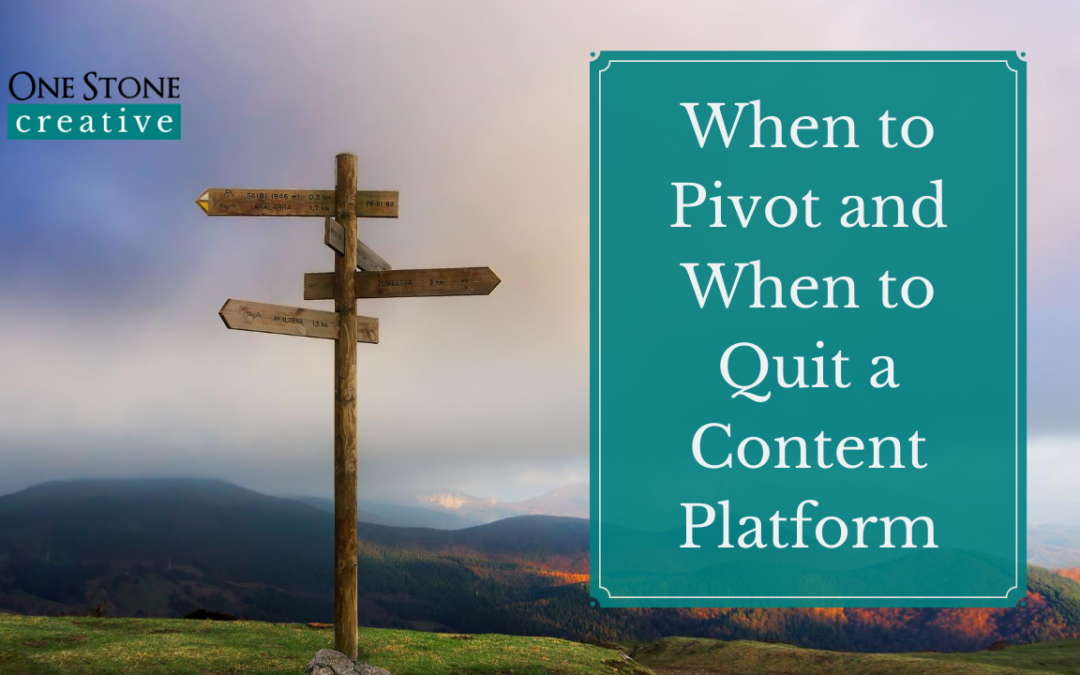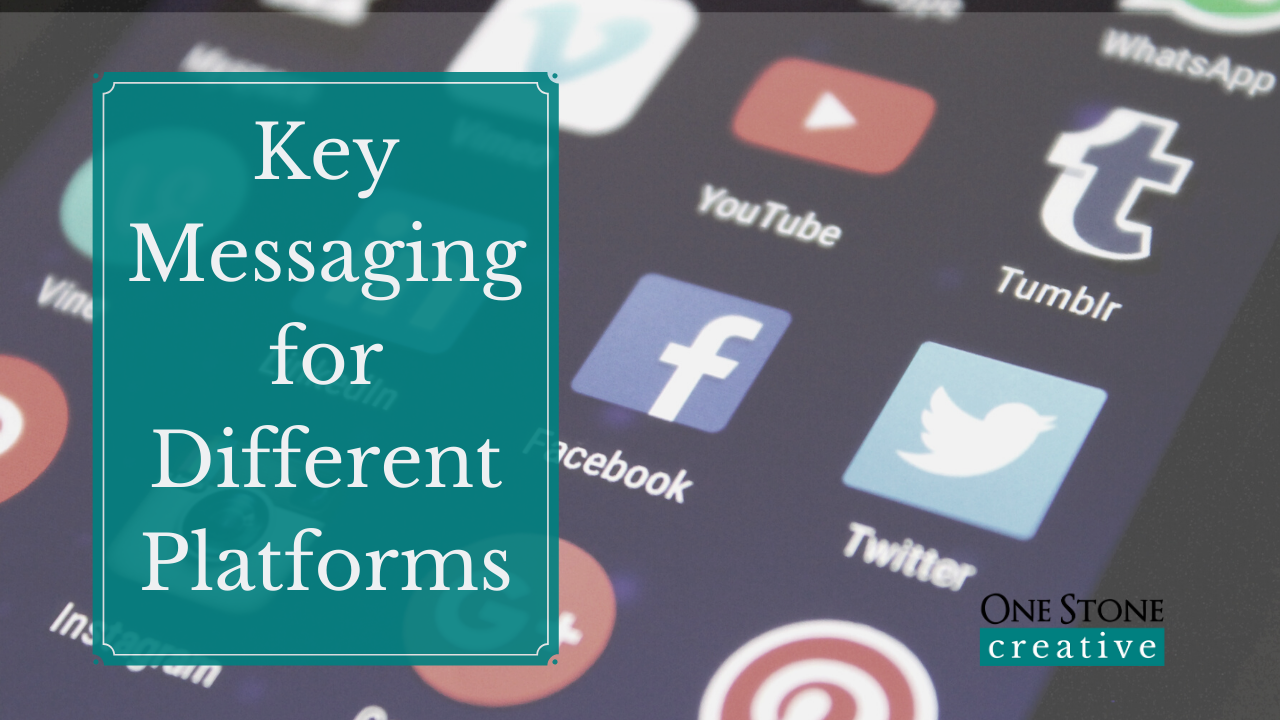You’ve heard that winners never quit and quitters never win.
There are areas in life where that is certainly true. Developing a new skill. Playing a sport.
I’m generally not a fan of it being applied to business and business decisions, however.
Sometimes quitting is the best choice but figuring out when it’s time to strategically re-invest your resources (see what I did there?) and when you’re simply giving up can be something of a challenge.
Maybe this will sound familiar to you:
You’re getting shares, you’re getting some engagement, leads are flowing in… all that is great, but it seems like it could be a little better.
Something needs to change, or improve or alter, because you’re getting kind of tired, and it’s not certain you’re going to see the kind of results you want from your content platforms.
You have to decide whether to pivot or quit.
When it comes to content creation, pivoting means altering your angle, message, audience or workflow. Quitting means just getting off the platform and doing something else.
We’ve all been there, and there is NO shame in saying, “You know what? YouTube isn’t for me!”
(This is a totally different conversation when you embarked on a new content platform with a clear understanding of your goals, what success would look like, and metrics you would measure to track success and the timeline you set. That changes things from “Do I pivot or quit?” to “Did the experiment work?” If you can, start with goals, if you’re already knee-deep – use the advice in this blog post.)
Pivot or Quit? Look at the Symptoms
You have a limited amount of time, money, and energy to invest in your content; you need to be smart about how you spend it. But sometimes, we feel blah about a platform because of something we could change – a different workflow, a different call to action, a different format.
Changing the right thing can make a HUGE difference.
So how do you decide if you pivot or quit?
We’ve got a series of symptoms we look at to help us and our clients make that decision. Now you can use them, too.
Production Woes
If you have workflow struggles, like people (or yourself!) missing deadlines, maintaining quality, or just constantly *scrambling* – then you should pivot, and either hire in some help or lighten the production load so you can manage it. Pivot.
If it’s your responsibility, and you can’t give it to anyone else, and you really, really, really hate it – just quit. Not every platform is for every business, and if sitting down in front of zoom to record an interview just makes you want to re-grout your shower, again, this month – give it up. Misery makes for bad professional content. Though you might consider a solo show. Quit.
If you absolutely hate creating a certain type of content – quit making it. Misery makes bad professional content. Click To Tweet
Feedback Speaks Loud and Clear
If you get unexpected feedback, like people are absolutely loving the action steps in your podcast but not the interviews, or the blog posts you release from time to time giving in-depth case studies get tons of traction, but your usual demonstrations and think pieces go nowhere – well that’s a good sign to do more of what works, and less of what doesn’t! Pivot.
If the overwhelming majority of the feedback you get on a content platform is negative – stop. You’re always going to get the occasional negative review, and constructive feedback is always a good sign, even if it’s not fun to hear – but if most of the comments you get are in the line of “this is boring, useless and wrong.” The platform might not be the right one for your message. Quit.
You’re Off-Target with Your Audience
If the audience you’re finding was NOT the one you were targeting – well that’s an interesting situation! Sometimes you’ll create content for a platform that you’re sure will attract and convert a certain type of person – but then, for some reason, their dads or direct reports are all over it.
Did you ever watch My Little Pony, Friendship is Magic? Chances are that unless you have an age-appropriate child, you haven’t. Unless you’re one of the hundreds of thousands of young adults who got *really* into it and created the Brony community. (Which is mostly delightful, and only occasionally unsettling.) No idea WHY it happened, but it did.
If it happens to you, you can either change your messaging so it appeals less to the people who like it (and hopefully more to the people you WANT to like it) or, you can develop a service offering for the folks whose attention you have. Pivot.
If you’re creating and creating and creating for months or years but you just aren’t getting any traction, and despite following the advice of your producers and promoting it thoroughly, you’re seeing less than a third of your target metrics – at some point, you have to accept that continuing is throwing good money after bad, and if you aren’t getting enough outside-the-metrics benefits to justify your time money and energy, you should probably let go of the sunk costs and give it up. Quit.
You See Growth, But It Is SLOW
If your growth is consistent, and slow to moderate, think carefully about whether or not you should give it up. If more people are watching, listening and commenting every month than there were last month – you’re doing SOMETHING right. Think about your audience targeting and your messaging, and the time you’re spending promoting – something in there is probably the key, and if you can optimize it, you can speed things up a little. Pivot.
You’re Specific Goal Is Not Being Attained
All right – the last one. If you are working diligently on a content platform for a specific goal – maybe a YouTube channel for conversions to one of your opt-ins, and the content that you’re making is not useful in ANY other area of your business, it might not be bad to do, but it might not be the best use of your resources. Given the choice, everything you make should have multiple uses, so if you’re feeling iffy about creating content, or you have a looming budget meeting, be prepared to let the single-use content go. Quit.
Review the Symptoms Then Go with Your Gut
And there we have it – this is how we decide whether to pivot or quit. Look for the symptoms, and see how many of each you have. If it’s a mix of pivot and quit indicators, you should go with your gut. Guts aren’t the MOST reliable marketing tools, but in the absence of rock-hard data, they do a pretty good job.
Doing the work of setting metrics goals for your content makes this a lot easier of course – so before you decide to give up on a year’s worth of podcasting, make sure you have accurate information about what you’ve done – and have exhausted the possibilities of what you COULD do.
About the Author

Megan Dougherty is the Co-Founder of One Stone Creative. She has been a digital marketer for over a decade, with a strong focus on digital course creation, content marketing and multi-media content production. As the co-founder, she takes pride in high-quality, on-time work and helping people get their messages to the people who need to hear them. She likes spreadsheets, deadlines and creating online experiences that are good for both the creators and the end-users. She hates jumping out of airplanes, mushrooms, and hyberbolic language in messaging. When not helping to produce podcasts, courses, and videos, she bakes pies and watches Star Trek. (Janeway forever.)




